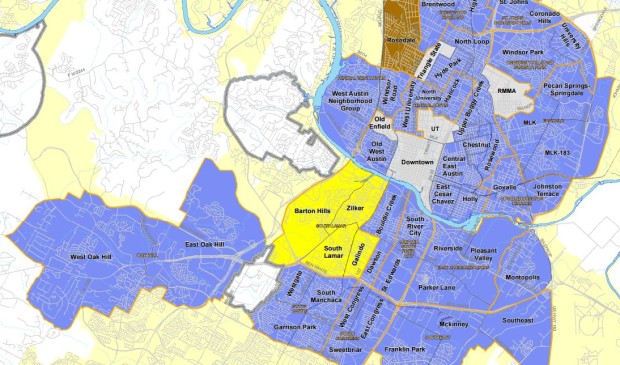City looks to strengthen contact team rules
Wednesday, September 23, 2015 by
Elizabeth Pagano The way that the city’s neighborhood-plan contact teams do business may be changing.
City Council Member Pio Renteria is pushing for code amendments that will create clearer guidelines and more city oversight for Austin’s contact teams. On Monday, his resolution was at the Planning and Neighborhoods Committee.
Neighborhood-plan contact teams manage adopted neighborhood plans in the city, reviewing and initiating plan amendments and serving as points of contact for the community, developers and city staff. Currently, there are 31 contact teams, covering just under half of Austin’s population.
Because not every neighborhood has a neighborhood plan, the contact teams sometimes overlap or conflict with neighborhood associations, according to a presentation by Planning and Zoning Assistant Director Matthew Lewis. In that presentation, Lewis enumerated other concerns that include a lack of transparency, low participation, a lack of diversity and the fact that the current practices aren’t based on the best practices of peer cities.
After hearing testimony from contact team members, Renteria backed away from the most controversial element in his resolution. That section asked the city manager to explore the possibility of changing the neighborhood planning boundaries and reorganizing the contact teams “into a larger, geographically coherent, and more manageable number of entities which may provide greater community representation and participation.”
“I wanted to see it discussed,” said Renteria. “It’s not like I am 100 percent behind that combined part of it, but I think it would be healthy if we allowed the staff and the stakeholders … to comment on that particular recommendation.”
With that accomplished, Renteria said he would “have no problem deleting that section” of the resolution. That decision was met with applause and thanks from Mayor Pro Tem Kathie Tovo, who said that she supported the rest of the resolution but would not support changing the geographic boundaries of the neighborhood contact teams.
So what’s left? As Renteria clarified, the overall intent of his resolution is to ensure that the city’s contact teams are “more open and inclusive.”
“While the city provides some guidelines now, there is little that can be done when teams operate outside of those guidelines or try to exclude many people from participating,” said Renteria.
To that end, the committee passed along a handful of proposed code amendments. The first would allow the city to formally recognize planning contact teams and require that the groups comply with (as yet unestablished) guidelines. If they don’t, the resolution proposes granting the city the power to “rescind recognition of a contact team.” The resolution also proposes establishing requirements for how meetings are advertised and where they are held, and for creating a process for handling contact team grievances.
A handful of contact team members were on hand to discuss the resolution, though almost everyone who spoke expressed concern that they were not alerted to the resolution in advance.
Susana Almanza, chair of the Montopolis Neighborhood Plan contact team, and Daniel Llanes, chair of the contact team for GoValle/Johnston Terrace, questioned Renteria’s motivations and expressed concern that the proposed code amendments were directed at their organizations.
“This is directed at (the) GoValle/Johnston Terrace contact team,” said Llanes. “They are trying to usurp our authority here.”
Llanes asked that the resolution be tabled, saying, “It is premature. … It is very misleading, disinformed and just flat-out wrong in many places.” He took particular issue with a short history of contact teams distributed by city staff, which he called “wrong, wrong, wrong.”
Elaborating, Llanes told the committee that his own contact team existed only because it refused to disband in 2005, against the wishes of city staff.
“All the way down the line, city staff has attempted to control our process. … City staff has continued to try to control and subvert the issue, and it is unfortunate that Council Member Renteria is now joining them,” said Llanes.
Almanza, who is also Renteria’s sister, worried aloud that the resolution was a way to speed gentrification on the east side.
“You really need to look at where Council Member Renteria is headed here,” said Almanza. “It’s a really scary, slippery slope we are going on, because there are teams that are in place that have been there for generations and now, all of a sudden, new people have come into the community, and they don’t like people of color being in the leadership positions.”
In contrast, AURA and Board of Adjustment member Eric Goff explained that the Holly neighborhood was currently looking to form a contact team. He thanked Renteria for the resolution.
“It’s good to have a level set of what’s expected,” said Goff. “I appreciate your putting that out ahead of time so we know what rules to follow. It makes sense to have standard bylaws.”
Map of neighborhood plans courtesy of the city of Austin.
You're a community leader
And we’re honored you look to us for serious, in-depth news. You know a strong community needs local and dedicated watchdog reporting. We’re here for you and that won’t change. Now will you take the powerful next step and support our nonprofit news organization?









